wiring CHEVROLET IMPALA 2004 8.G Owners Manual
[x] Cancel search | Manufacturer: CHEVROLET, Model Year: 2004, Model line: IMPALA, Model: CHEVROLET IMPALA 2004 8.GPages: 420, PDF Size: 2.73 MB
Page 79 of 420
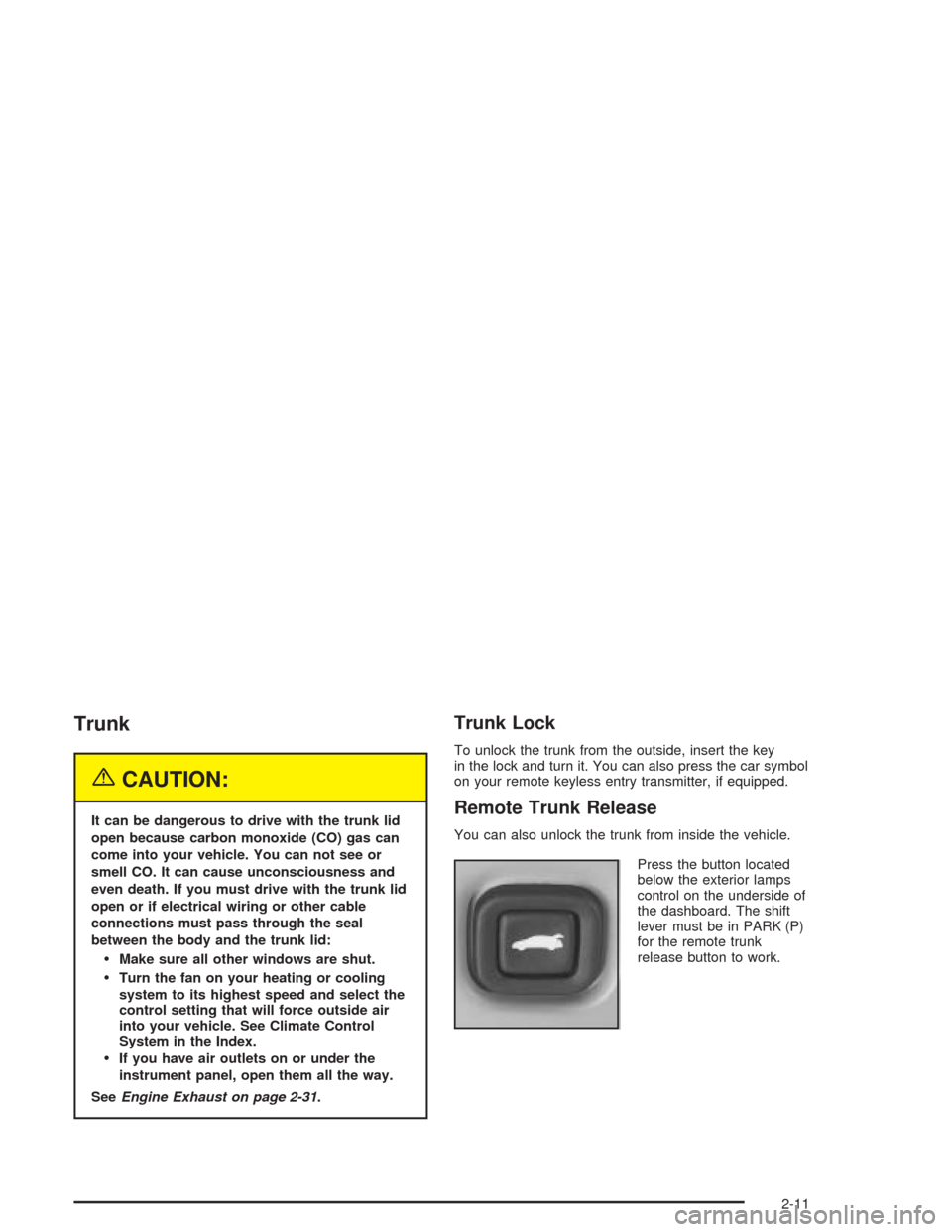
Trunk
{CAUTION:
It can be dangerous to drive with the trunk lid
open because carbon monoxide (CO) gas can
come into your vehicle. You can not see or
smell CO. It can cause unconsciousness and
even death. If you must drive with the trunk lid
open or if electrical wiring or other cable
connections must pass through the seal
between the body and the trunk lid:
Make sure all other windows are shut.
Turn the fan on your heating or cooling
system to its highest speed and select the
control setting that will force outside air
into your vehicle. See Climate Control
System in the Index.
If you have air outlets on or under the
instrument panel, open them all the way.
SeeEngine Exhaust on page 2-31.
Trunk Lock
To unlock the trunk from the outside, insert the key
in the lock and turn it. You can also press the car symbol
on your remote keyless entry transmitter, if equipped.
Remote Trunk Release
You can also unlock the trunk from inside the vehicle.
Press the button located
below the exterior lamps
control on the underside of
the dashboard. The shift
lever must be in PARK (P)
for the remote trunk
release button to work.
2-11
Page 152 of 420
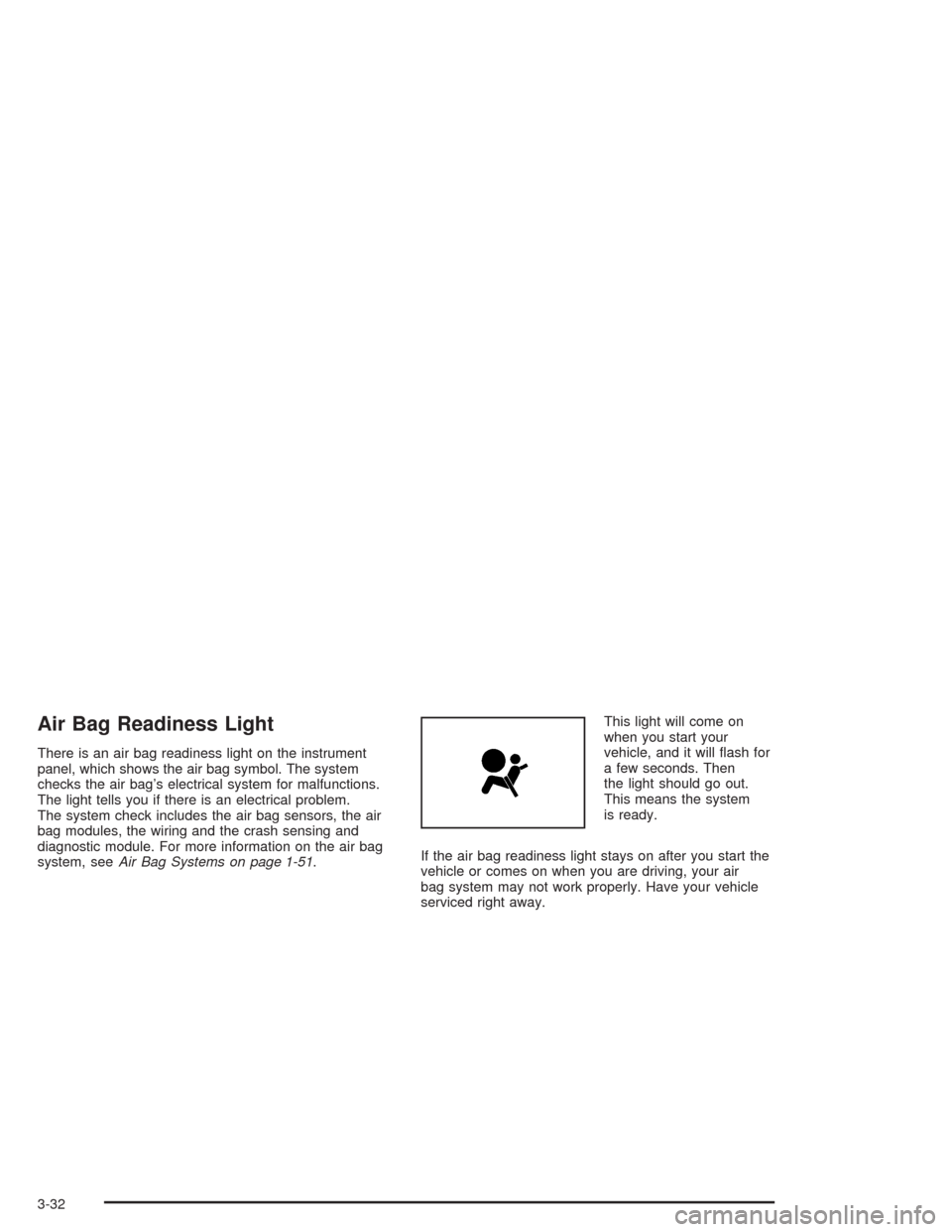
Air Bag Readiness Light
There is an air bag readiness light on the instrument
panel, which shows the air bag symbol. The system
checks the air bag’s electrical system for malfunctions.
The light tells you if there is an electrical problem.
The system check includes the air bag sensors, the air
bag modules, the wiring and the crash sensing and
diagnostic module. For more information on the air bag
system, seeAir Bag Systems on page 1-51.This light will come on
when you start your
vehicle, and it will �ash for
a few seconds. Then
the light should go out.
This means the system
is ready.
If the air bag readiness light stays on after you start the
vehicle or comes on when you are driving, your air
bag system may not work properly. Have your vehicle
serviced right away.
3-32
Page 260 of 420

Making Turns
Notice:Making very sharp turns while trailering
could cause the trailer to come in contact with the
vehicle. Your vehicle could be damaged. Avoid
making very sharp turns while trailering.
When you’re turning with a trailer, make wider turns
than normal. Do this so your trailer won’t strike
soft shoulders, curbs, road signs, trees or other objects.
Avoid jerky or sudden maneuvers. Signal well in
advance.
Turn Signals When Towing a Trailer
When you tow a trailer, your vehicle may need additional
wiring. Check with your dealer. The arrows on your
instrument panel will �ash whenever you signal a turn or
lane change. Properly hooked up, the trailer lamps
will also �ash, telling other drivers you’re about to turn,
change lanes or stop.
When towing a trailer, the arrows on your instrument
panel will �ash for turns even if the bulbs on the trailer
are burned out. Thus, you may think drivers behind
you are seeing your signal when they are not. It’s
important to check occasionally to be sure the trailer
bulbs are still working.
Driving On Grades
Reduce speed and shift to a lower gearbeforeyou start
down a long or steep downgrade. If you don’t shift
down, you might have to use your brakes so much that
they would get hot and no longer work well.
On a long uphill grade, shift down and reduce your
speed to around 45 mph (70 km/h) to reduce the
possibility of engine and transaxle overheating.
If you have overdrive, you may want to drive in
THIRD (3) instead of AUTOMATIC OVERDRIVE
X.
Parking on Hills
{CAUTION:
You really should not park your vehicle, with a
trailer attached, on a hill. If something goes
wrong, your rig could start to move. People
can be injured, and both your vehicle and the
trailer can be damaged.
4-42
Page 264 of 420
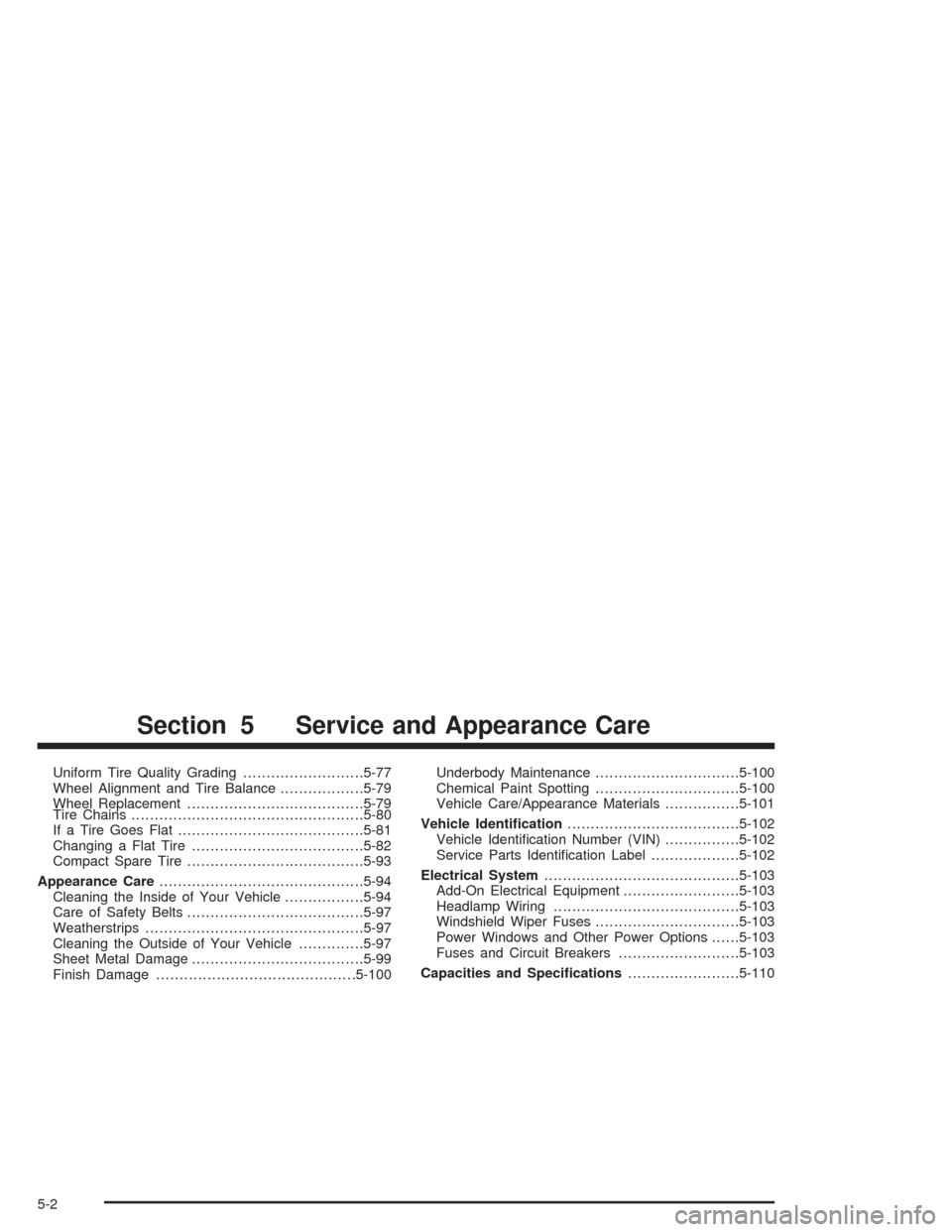
Uniform Tire Quality Grading..........................5-77
Wheel Alignment and Tire Balance..................5-79
Wheel Replacement......................................5-79
Tire Chains..................................................5-80
If a Tire Goes Flat........................................5-81
Changing a Flat Tire.....................................5-82
Compact Spare Tire......................................5-93
Appearance Care............................................5-94
Cleaning the Inside of Your Vehicle.................5-94
Care of Safety Belts......................................5-97
Weatherstrips...............................................5-97
Cleaning the Outside of Your Vehicle..............5-97
Sheet Metal Damage.....................................5-99
Finish Damage...........................................5-100Underbody Maintenance...............................5-100
Chemical Paint Spotting...............................5-100
Vehicle Care/Appearance Materials................5-101
Vehicle Identi�cation.....................................5-102
Vehicle Identi�cation Number (VIN)................5-102
Service Parts Identi�cation Label...................5-102
Electrical System..........................................5-103
Add-On Electrical Equipment.........................5-103
Headlamp Wiring........................................5-103
Windshield Wiper Fuses...............................5-103
Power Windows and Other Power Options......5-103
Fuses and Circuit Breakers..........................5-103
Capacities and Speci�cations........................5-110
Section 5 Service and Appearance Care
5-2
Page 365 of 420
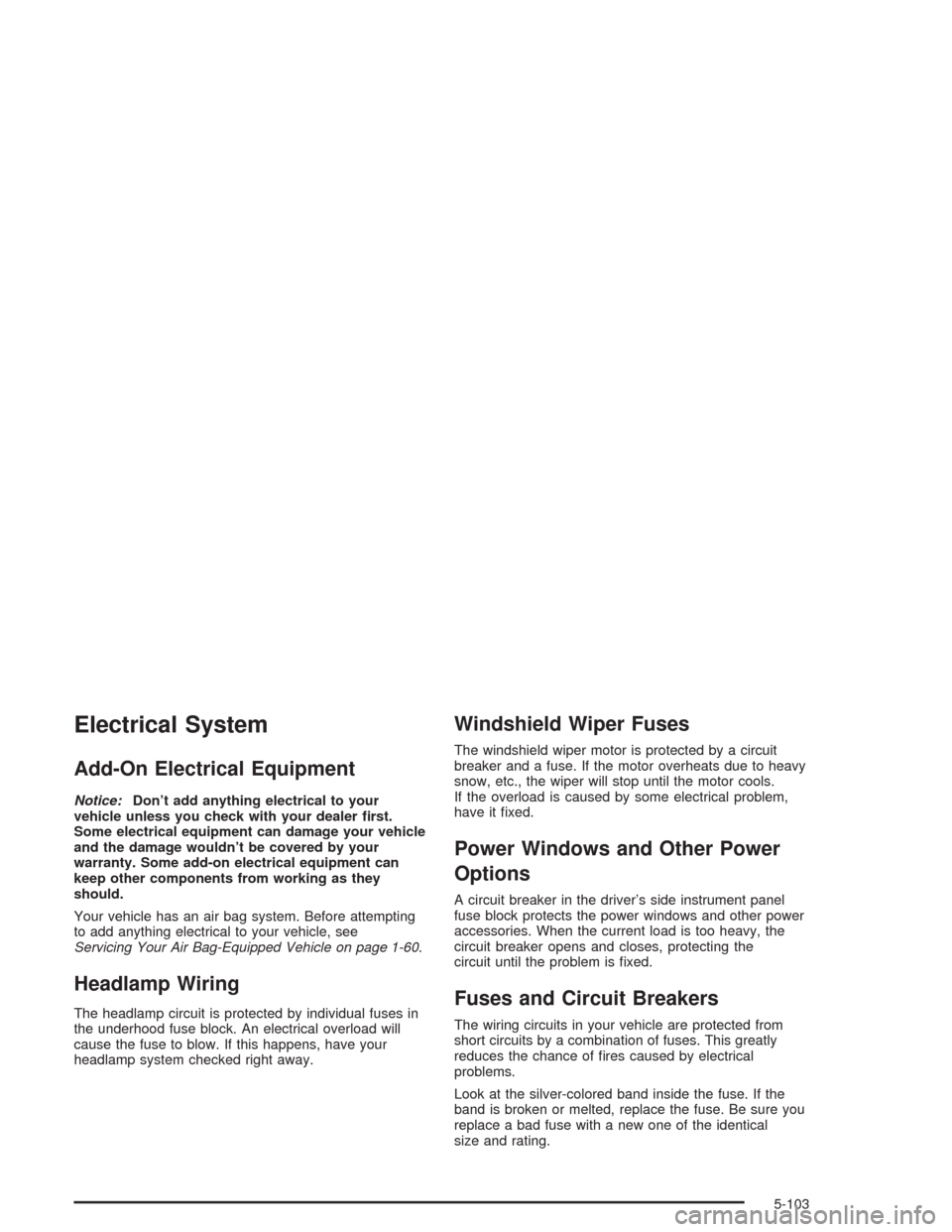
Electrical System
Add-On Electrical Equipment
Notice:Don’t add anything electrical to your
vehicle unless you check with your dealer �rst.
Some electrical equipment can damage your vehicle
and the damage wouldn’t be covered by your
warranty. Some add-on electrical equipment can
keep other components from working as they
should.
Your vehicle has an air bag system. Before attempting
to add anything electrical to your vehicle, see
Servicing Your Air Bag-Equipped Vehicle on page 1-60.
Headlamp Wiring
The headlamp circuit is protected by individual fuses in
the underhood fuse block. An electrical overload will
cause the fuse to blow. If this happens, have your
headlamp system checked right away.
Windshield Wiper Fuses
The windshield wiper motor is protected by a circuit
breaker and a fuse. If the motor overheats due to heavy
snow, etc., the wiper will stop until the motor cools.
If the overload is caused by some electrical problem,
have it �xed.
Power Windows and Other Power
Options
A circuit breaker in the driver’s side instrument panel
fuse block protects the power windows and other power
accessories. When the current load is too heavy, the
circuit breaker opens and closes, protecting the
circuit until the problem is �xed.
Fuses and Circuit Breakers
The wiring circuits in your vehicle are protected from
short circuits by a combination of fuses. This greatly
reduces the chance of �res caused by electrical
problems.
Look at the silver-colored band inside the fuse. If the
band is broken or melted, replace the fuse. Be sure you
replace a bad fuse with a new one of the identical
size and rating.
5-103
Page 409 of 420
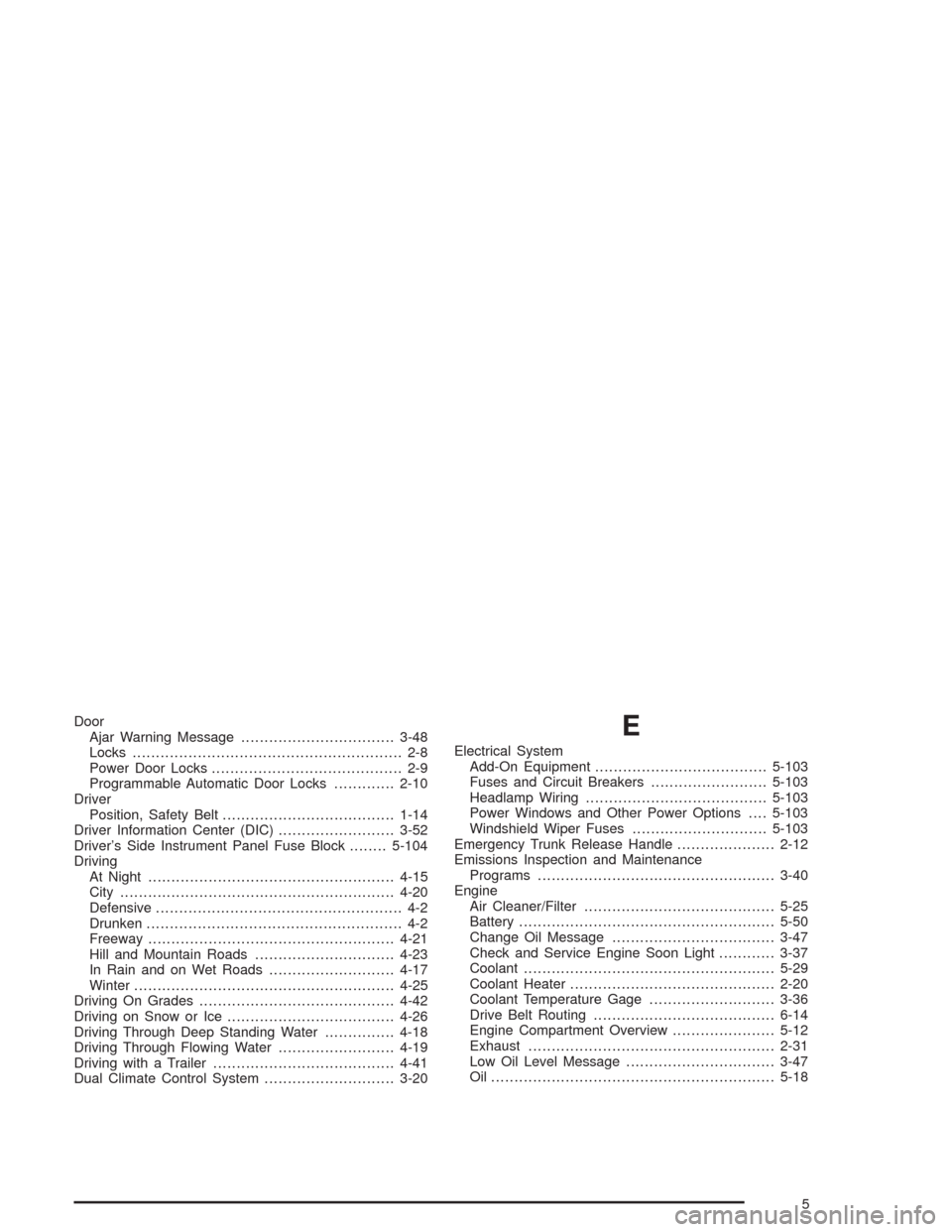
Door
Ajar Warning Message.................................3-48
Locks.......................................................... 2-8
Power Door Locks......................................... 2-9
Programmable Automatic Door Locks.............2-10
Driver
Position, Safety Belt.....................................1-14
Driver Information Center (DIC).........................3-52
Driver’s Side Instrument Panel Fuse Block........5-104
Driving
At Night.....................................................4-15
City...........................................................4-20
Defensive..................................................... 4-2
Drunken....................................................... 4-2
Freeway.....................................................4-21
Hill and Mountain Roads..............................4-23
In Rain and on Wet Roads...........................4-17
Winter........................................................4-25
Driving On Grades..........................................4-42
Driving on Snow or Ice....................................4-26
Driving Through Deep Standing Water...............4-18
Driving Through Flowing Water.........................4-19
Driving with a Trailer.......................................4-41
Dual Climate Control System............................3-20E
Electrical System
Add-On Equipment.....................................5-103
Fuses and Circuit Breakers.........................5-103
Headlamp Wiring.......................................5-103
Power Windows and Other Power Options....5-103
Windshield Wiper Fuses.............................5-103
Emergency Trunk Release Handle.....................2-12
Emissions Inspection and Maintenance
Programs...................................................3-40
Engine
Air Cleaner/Filter.........................................5-25
Battery.......................................................5-50
Change Oil Message...................................3-47
Check and Service Engine Soon Light............3-37
Coolant......................................................5-29
Coolant Heater............................................2-20
Coolant Temperature Gage...........................3-36
Drive Belt Routing.......................................6-14
Engine Compartment Overview......................5-12
Exhaust.....................................................2-31
Low Oil Level Message................................3-47
Oil .............................................................5-18
5
Page 411 of 420
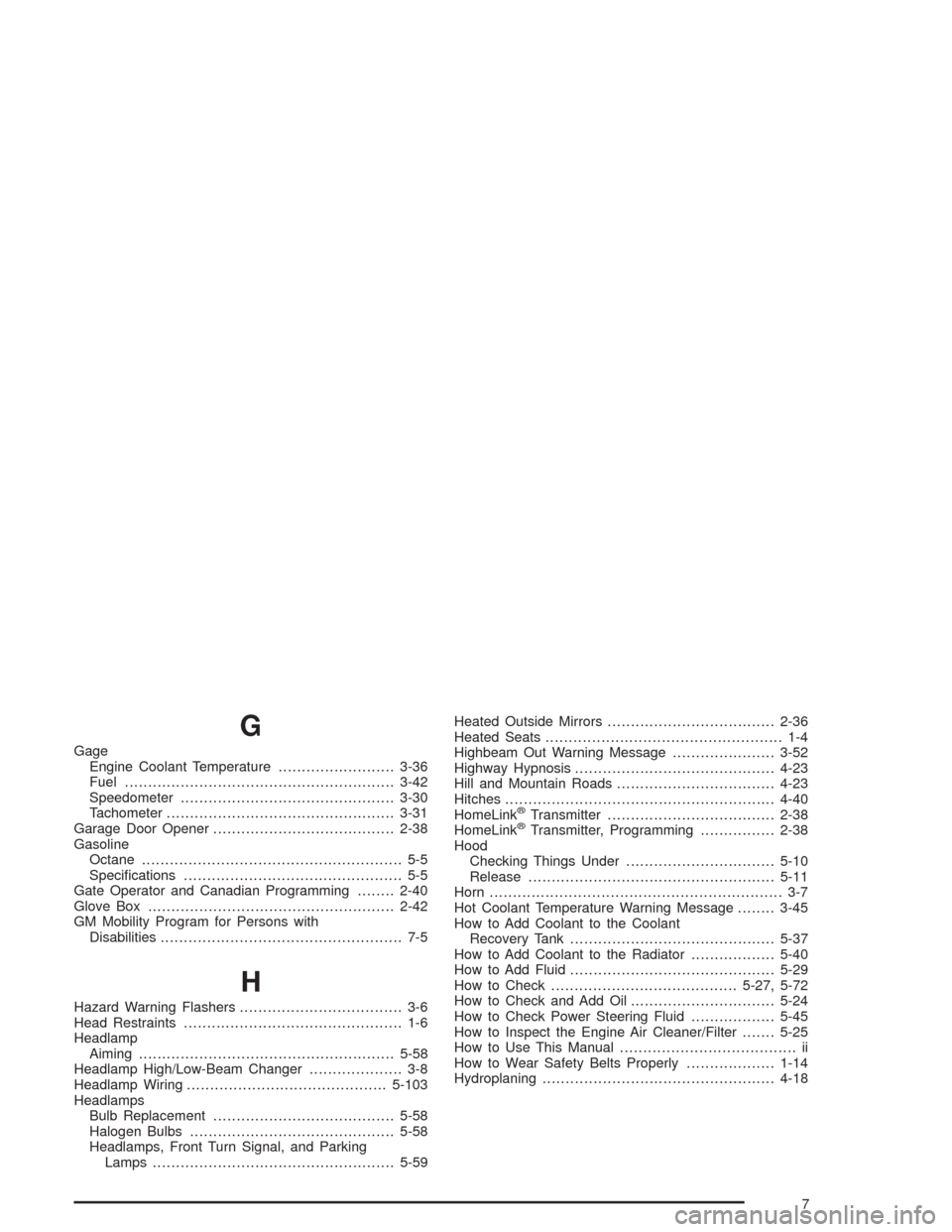
G
Gage
Engine Coolant Temperature.........................3-36
Fuel..........................................................3-42
Speedometer..............................................3-30
Tachometer.................................................3-31
Garage Door Opener.......................................2-38
Gasoline
Octane........................................................ 5-5
Speci�cations............................................... 5-5
Gate Operator and Canadian Programming........2-40
Glove Box.....................................................2-42
GM Mobility Program for Persons with
Disabilities.................................................... 7-5
H
Hazard Warning Flashers................................... 3-6
Head Restraints............................................... 1-6
Headlamp
Aiming.......................................................5-58
Headlamp High/Low-Beam Changer.................... 3-8
Headlamp Wiring...........................................5-103
Headlamps
Bulb Replacement.......................................5-58
Halogen Bulbs............................................5-58
Headlamps, Front Turn Signal, and Parking
Lamps....................................................5-59Heated Outside Mirrors....................................2-36
Heated Seats................................................... 1-4
Highbeam Out Warning Message......................3-52
Highway Hypnosis...........................................4-23
Hill and Mountain Roads..................................4-23
Hitches..........................................................4-40
HomeLink
®Transmitter....................................2-38
HomeLink®Transmitter, Programming................2-38
Hood
Checking Things Under................................5-10
Release.....................................................5-11
Horn............................................................... 3-7
Hot Coolant Temperature Warning Message........3-45
How to Add Coolant to the Coolant
Recovery Tank............................................5-37
How to Add Coolant to the Radiator..................5-40
How to Add Fluid............................................5-29
How to Check........................................5-27, 5-72
How to Check and Add Oil...............................5-24
How to Check Power Steering Fluid..................5-45
How to Inspect the Engine Air Cleaner/Filter.......5-25
How to Use This Manual...................................... ii
How to Wear Safety Belts Properly...................1-14
Hydroplaning..................................................4-18
7